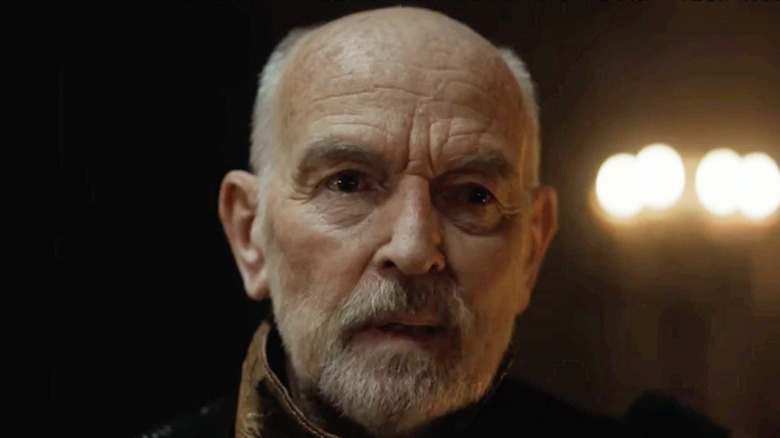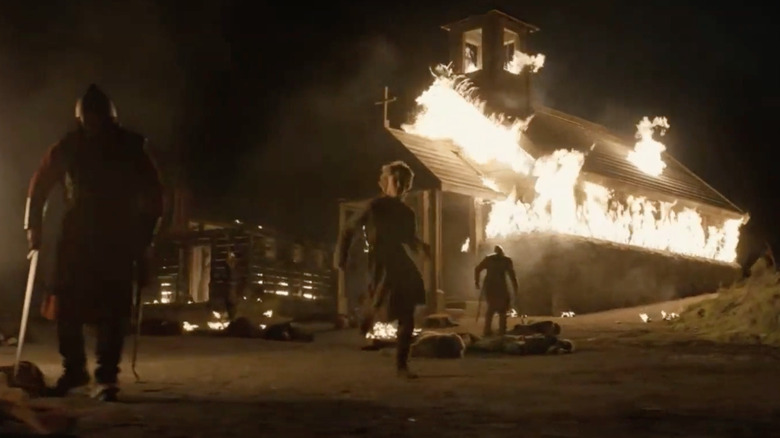The St. Brice's Day Massacre In Vikings: Valhalla Explained
Much like History's "Vikings," Netflix's "Vikings: Valhalla" mixes history and fiction in a way that familiarizes audiences with real-life figures, while also showing viewers a bunch of things those figures' authentic counterparts likely never actually did (via JosephWriterAnderson). In the case of the upcoming Netflix series, writers have specifically chosen to focus the narrative on Norse legends like Leif Erikson (Sam Corlett), Freydis Eriksdotter (Frida Gustavsson), King Canute the Great (Bradley Freegard), and a variety of other people who lived around the same time.
Though most of the character interactions are highly fictionalized, some of the events portrayed in the series are based on historical record. In the very first scene of Season 1, Episode 1 ("The Greenlanders"), King Æthelred II (Bosco Hogan) orders a team of Vikings warriors into his palace. Æthelred insists that their presence is needed urgently and apologizes for interrupting Saint Brice's Day feasts, but then sees fit to suddenly review international relations between the Danes and Saxons throughout the prior century.
Though the unnamed Viking leader explains that many of his people no longer remember their native language and largely consider themselves Saxon, the King immediately insists the Danes are not Saxon at all and announces his intention to exterminate all Viking people in England. What follows is likely to be compared to the infamous Red Wedding of "Game of Thrones" (via GOT Fandom). However, this event differs in one very important way. Unlike Walder Frey's betrayal of the Starks, the Saint Brice's Day Massacre is a thing that actually happened.
Æthelred the Unready was ready to start the fire
Billy Joel's "We Didn't Start the Fire" may not have covered history going all the way back to the 10th and 11th centuries, but if it did, he might have needed to consider a change in lyrics. Although he may not have been entirely to blame, King Æthelred the Unready certainly started a fire with the Saint Brice's Day Massacre in 1002. Reliable historical records on the event are somewhat spotty, but we have a pretty good idea about why Æthelred made such an order. According to Historic UK, Æthelred was informed that the Danes intended to "faithlessly take his life, and then all his councillors and then possess his kingdom." Though it is unknown if this was a legitimate threat, Danes had repeatedly pillaged English villages in recent years. In response, the king ordered the extermination of all Danes in England.
Although it certainly seems somewhat unlikely that he would have invited warriors to his palace just to murder them, there is a plethora of evidence suggesting an attempted genocide of Viking people actually took place that year. The exact number of casualties from the massacre is also difficult to ascertain, but evidence discovered a whole millennium later gives a few clues. According to the BBC, a total of 35 skeletons belonging to young Viking men were discovered buried in Oxford in 2008. Subsequent examination of the remains indicated that each man had been violently murdered, including a number who had been burned prior to burial.
Once carbon dating placed the origins of the remains at sometime between 960 and 1020, historians and archaeologists quickly realized the bones likely originated from the Saint Brice's Day Massacre. A royal charter issued by Æthelred in 1014 called the massacre "a most justified extermination," and, most interestingly, made reference to the burning of a church in order to kill a number of Danes who had sought refuge there, much like in "Vikings: Valhalla" (via Heritage Daily).

